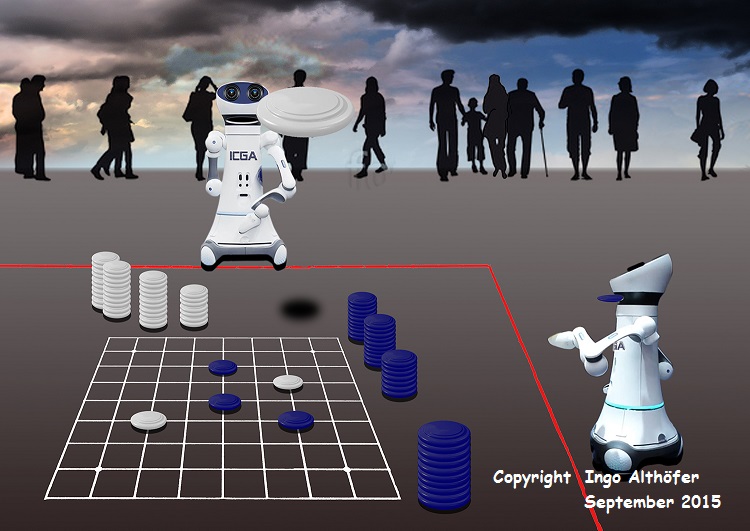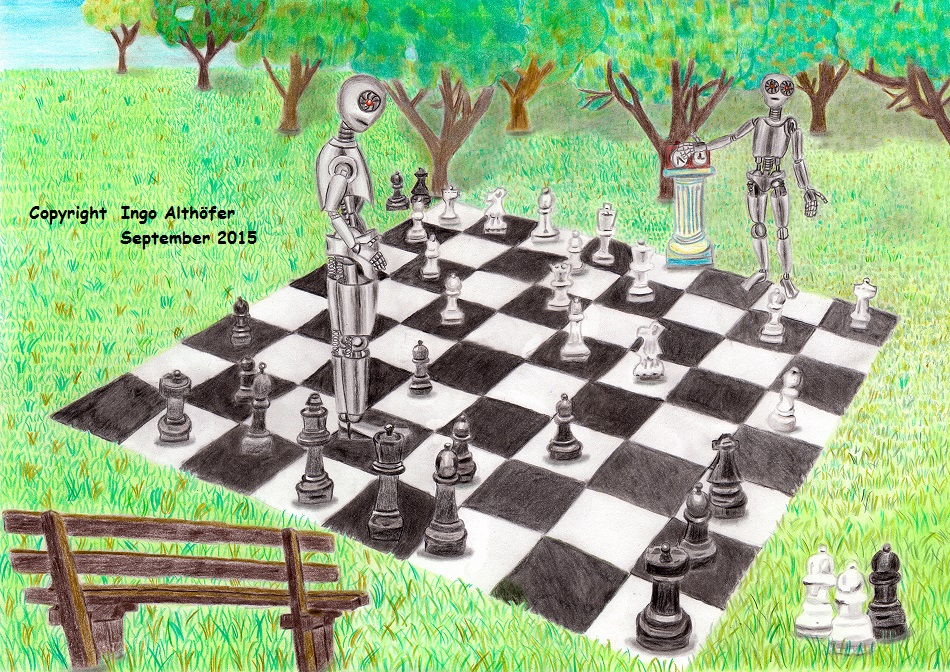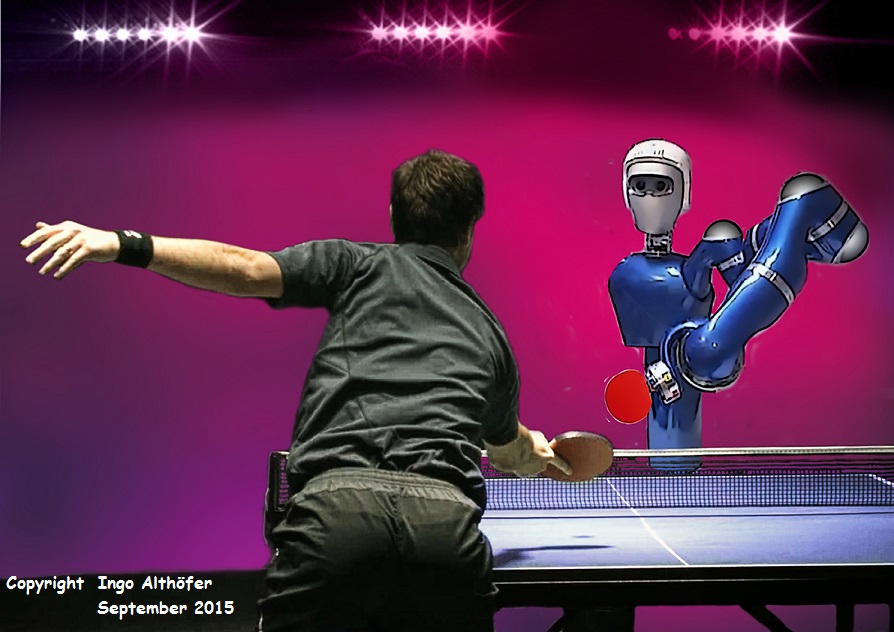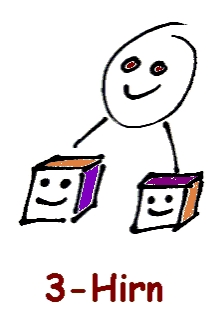Intelligent Game Play by Robots
Ingo Althofer, September 18, 2015;
Updates: March 31, 2016 and June 27, 2021
One of my research interests is intelligent game play by computers.
More difficult than this is
intelligent play of games with a physical component
by robots. For a long time already I have
been thinking about three rather different challenges.
(1) Frisbee Go, played by Robots
In 2000, the annual European Go Congress took place in
Berlin-Strausberg. There were lots of events and side events.
One eye catcher was a 9x9 net on a green meadow. There
were lots of blue and white frisbees, and they were used
as playing stones in a 9x9 go game. The net was the board.
The players had to keep some meters distance from the net and
- when it was their turn - had to throw one of the frisbees
of their color.
If it landed on a free crossing of the net, this counted as
a move. If not, there was the chance of repetition. After three
unsuccessful tries the move was counted as a pass move.
To be successful in Frisbee Go, a player needs the understanding
of Go, the skill to steer the frisbees, and - knowing the
own frisbee skill and that of the opponent - to take this into
consideration when chosing a move.

There exist already robots "shooting" frisbees. Have a look for instance in
this video.
Anyhow, the task to play Frisbee Go on an "interesting" level
is far from non-trivial.
Instead of handicap stones (like in traditional go) stronger
players may have to throw from a larger distance.
The German Go Association has a set with a 9x9-net, 41 dark
blue, and 40 white frisbee disks for frisbee go...
Frisbee Go Simulation
The Computer Olympiad 2016, organized by the ICGA, will take place between
June 27 and July 03 in Leiden (NL). One of the new disciplines is "Frisbee Go Simulation"
on 9x9 boards. It is a fully digital game, however with an element of chance:
When a stone is meant to be placed on cell (i,j), then it will go there only
with probability 1 - 4*eps. Each of the four neighboring cells, namely (i-1,j),
(i+1,j), (i,j-1), (i,j+1) will be hit with probability eps each. The competition
in 2016 will be played with eps= 1/8.
(2) Robot Blitz Chess on Very Big Boards
Here, by "big" I do not mean chess boards with for instance
20x20 squares, but 8x8 boards in outdoor size. Typically, on such
a board each square has side length 50 centimeters. So the
board in total is 4m x 4m. Blitz Chess means that play
is executed under strict (and short) time limits, for instance
5 minutes for each side for the whole game. In
performance-oriented outdoor chess,
the chess clock is placed on a stand, in the middle at one
side of the board (often near the squares a4 and a5).

The robots shall perform "all" tasks: recognizing the
position, computing, moving the pieces, operating the
clock.
A simplified version of this took place in May
2011, in an exhibition event in Moscow: small/normal chess
board, blitz chess by robots (two different "machines" from
Germany's KuKa company),
simplified task of board recognition by "many" helpful
marks in and around the board (total size 60cm x 60cm).
The robots were fixed on stands and each one had an arm for
executing the moves.
Michael Hartisch (in those days math student at Jena University)
took this event as a starting point for an investigation in his
B.Sc. thesis. Michael developed an algorithm to compute endgame
data bases for the situation where each move has its own length
(instead of the standard length "1"). For instance, in the basic
endgame with King plus Rook vs. King it turned out
that there are several situations
where the optimal robot move is different from the optimal move
in classic "distance to mate" fashion.
Robot Blitz Chess on big boards will be very entertaining,
also for spectators who do not understand the intricacies of chess.
(3) Robot Table Tennis
In 2014, almost simultaneously two Youtube videos showed
robots playing table tennis on a (very) high level.
Ulf Hoffmann Tischtennis Roboter
and
Timo Boll vs. KUKA Robot
Soon it became common knowledge that both videos only showed
fake duels. Having robots mastering table tennis is a challenge
still far beyond the horizon of current technology. Nevertheless,
I hope to be still alive when a robot challenges the human
World Champion in table tennis

Comparing the Tasks
All three tasks are real challenges. If I had to order them
by increasing difficulty (for robot strength in competitive
play against strong humans), my answer would be:
Robot Outdoor Blitz Chess
is easier than
Robot Frisbee Go
is easier than
Robot Table Tennis.
But who knows ...
My Background
One of my backgrounds is intelligent game play by computers:
Back in 1985, I introduced the 3-Hirn approach and applied
it to the game of chess.
Between 1985 and 1997 many experiments showed that 3-Hirn
gives 200 extra rating points for a wide range of computer
strengths and opponents. The experiences are documented in
many reports and in particular in the book "13 Jahre 3-Hirn -
Meine Schach-Experimente mit Mensch-Maschinen-Kombinationen".
The book is written in German, a rough translation of the title
is "13 Years of 3-Hirn - My Chess Experiments with Man-Machine
Combinations". Here "machine" is meant in its plural form.

One of my doctoral students is
Stefan Meyer-Kahlen, the father of chess program Shredder.
Shredder won 18 World Championship titles (in words: eighteen)
in computer chess between 1996 and 2015.
Together, my diploma student Timo Klaustermeyer (now
Timo Haupt) and I introduced the concept of "Freestyle Chess"
back in 2004: Freestyle chess is played by teams. Each team has a
distinguished captain and arbitrary helpers. These helpers may
be other human players, books, magazines, computer programs,
data bases, and whatever else might help. (Later, Garry Kasparov
adopted this term, forgetting to mention its creators...)
Since year 2000, I am active in the field of computer-aided
Go (Go is the famous traditional Asian board game) - with two hopes:
* To help beating the best human players by "freestyle teams"
of amateurs and computer programs before 2020.
* To help that computer Go programs alone (without human help)
beat the best human players before 2027.
Currently, the best strong go bot for analysis purposes is
CrazyStone 2013, developed by pioneer Remi Coulom.
See this screenshot:

Back to the main site of althofer.de




